There are multiple benefits to having a well-defined career readiness program that spans an entire college or university or is at least available to all students, says David Gaston, Ed.D., assistant vice provost for academic success at the University of Kansas – Career & Experiential Learning and co-chair of the NACE Career Readiness Integration Task Force.
Chief among them is equipping students to meet their career goals.
“We must remember that nearly nine out of 10 students report that their primary motivation for pursuing a bachelor’s degree is career related. That being the case, institutions should honor that motivation and integrate career readiness across the curriculum,” Dr. Gaston explains.
“In my experience, a focus on developing and executing an exceptional process leads to desired outcomes. If students desire positive career outcomes, institutions need to ensure that students develop the skills necessary to achieve those career outcomes. Career readiness competencies provide a shared roadmap and a common language for those developing programs and curricula.”
At University of Kansas, a large majority of students work while they are in school, which limits their time to take advantage of support services, such as the career center and the writing center, outside of the formal curriculum.
“Consequently,” Dr. Gaston continues, “we have worked hard to integrate career into the curriculum. For example, we have worked with faculty leaders from academic departments to evaluate their curricula through the lens of career readiness. Faculty are often pleased to learn that career competencies are represented to a much greater degree than they believed before beginning the effort.
“For those things that are not formally included in the curriculum, we worked with faculty to identify campus partners that can help students achieve those competencies and developed a referral process.”
Dr. Gaston points out that as institutions become more dependent upon tuition revenue and the support of external partners interested in economic and workforce development, securing buy from campus stakeholders is increasingly becoming an imperative.
“It is important to keep in mind that institutional leaders come from many different backgrounds and may or may not have career readiness as part of their experience or expertise,” he says.
“Those who do, particularly those in career services, need to be well-schooled in career readiness programs and have thought about how it might be administered on their campus. Influencing up and across is a particular skill that can be daunting, but the more defined an initiative can be, the easier it will be to communicate to stakeholders.”
There are several factors to consider when identifying key stakeholders to involve in this initiative. For example, is it a required or elective program or curriculum? How far “across campus” will it extend?
Regardless, Dr. Gaston says, there needs to be a common language, which would be the competencies or a similar model.
“There must be persistence and patience as colleges and universities often take a long time to pivot,” he explains.
“The new language of career readiness or competencies should permeate and be discussed whenever possible. Eventually, those conversations will turn into action, either as an institutional initiative or as a collaboration across units. In the best-case scenario, these career readiness initiatives span academic units, campus leadership, student success, career services, and more.”
Dr. Gaston says the more successful initiatives at University of Kansas have included partnering with academic units to integrate career into the curriculum. Examples include:
- The inclusion of a career course or courses into the required curriculum;
- Consulting with faculty and evaluating their department’s curriculum through the lens of career readiness; and
- Providing plug-and-play career readiness content for use in faculty courses for both in-person and online courses.
There are various challenges associated with implementing career readiness competencies on campus. For example, Dr. Gaston says that, as it has been with career services in general, getting support from some faculty members who are not quite as keen on making the direct connection between an academic degree and career outcomes is one obstacle.
“In this instance,” he says, “it is important to provide a broad rationale as to why it is important to make this connection, particularly to the vast majority of undergraduate students motivated to attend college for career-related reasons.”
Another significant challenge at this point in the development of career readiness programs is measuring their effectiveness.
“Right now, it is really focused on self-reporting, unless it is tied to some academic course,” Dr. Gaston explains.
“Some programs have included supervisor evaluations in student employment and internship settings. Those results can be used to assess any gap there might be between student and supervisor training.”
He adds that the NACE Career Readiness Integration Task Force is working to put together a research agenda that will encourage efforts to develop more robust assessment measures.
During his experience implementing career readiness competencies on campus, Dr. Gaston has learned the importance of preparation and persistence in this pursuit.
“Career services leaders and their collaborators must have a vision of what career readiness looks like for students on their campus,” he says.
“This vision must be easily communicated. These partners must also be willing and able to share this vision repeatedly with many institutional stakeholders, often over an extended period of time.”
Doing so will be instrumental in the career readiness program realizing its goals, which, Dr. Gaston explains, include enhancing the professional success of students and graduates, increasing the number of students securing positive professional outcomes, and demonstrating the positive relationship between earning a college degree and achieving professional success.






